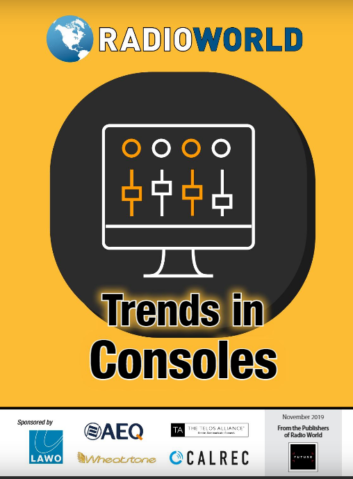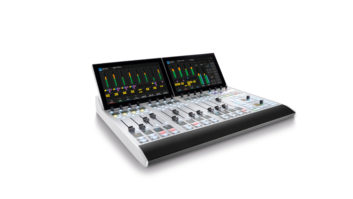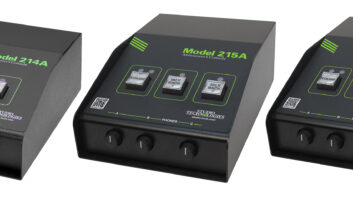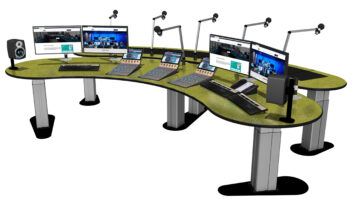 The author is chief engineer of WBUR Boston and was founding technical editor of Radio World Engineering Extra. This article appeared in the ebook “Trends in Consoles.”
The author is chief engineer of WBUR Boston and was founding technical editor of Radio World Engineering Extra. This article appeared in the ebook “Trends in Consoles.”
The dominant technical trend for radio and broadcast consoles is audio over IP, which is being offered by the largest manufacturers. Radio studio consoles are some of the best-suited applications for AoIP, with most of the commercial radio world parsed into studio-aggregated sites with a dozen or so studio rooms. Even the larger public radio groups are doing buildouts with 10 or more studio rooms in recent renovations. AoIP shines for this application because of the ability to interconnect a large number of mix rooms together with very limited interstudio wiring.
What distinguishes this group is the benefit they can achieve from a large, centralized router core. AoIP systems provide that router core, although it may physically be distributed amongst many rooms or consist of interconnected segments in one giant technical center.
STRENGTH IN TRANSPORT
At the same time, other pro users can be roughly divided into the “professional sound” community (where Dante is just taking over everything not already subsumed by MADI) and the “prosumer” group.
The pro sound people are every bit as concerned about high reliability/high performance as the broadcasters traditionally have been. But it is actually quite a huge difference that they are not as likely to benefit from a high-capacity central router (say, 200 x 200 or larger). For live sound you need the ability to get many signals from the stage to multiple mix points, such as front-of-house and/or an independent monitor mix location. This needs to be done efficiently and over increasingly long distances. Dante or MADI over fiber from stage boxes to a couple of mix positions fills this need quite nicely with 64 independent signals combined on one digital Category 5 cable.
[Read “How to Choose Your Next Radio Console”]
What live sound doesn’t need is a lot common sources to be shared amongst multiple stages. Even at festivals it’s unlikely that anyone would attempt to mix multiple stages in a centralized location. Not a good idea.
So now we find these great AoIP transport systems (like Dante and MADI) being brought over and adapted to broadcast consoles. The top-tier broadcast manufacturers are then building out router controllers in software that allow the core to be distributed into as many locations as needed. Broadcasters require the ability to restrict sources to certain mixer surfaces, so that we can control visibilities and access for easier, less error-prone operation by non-technical people. The key difference is that any and all of these mixers can access any and all of the sources and destinations as they need or want to.
SIMPLE SYSTEMS
In the third area, prosumer users resemble the old two-room studio sites where a single radio station would have a main and a backup production mixer. In the past, any cross-connections might be handled by an inexpensive router or brute-force wiring of analog/digital pairs. This is also a valid approach for small sound reinforcement systems or home studios. The specific niche for broadcasters is basically the stereo fader and the lack of complicated equalization knobs, which cause a combo announcer more problems than they are worth. There is still a fairly large market for this kind of equipment in the small to medium-size markets or at small public radio stations. The better quality gear is built for excellent reliability.
HOW LARGE CAN YOU GO?
Getting back to the high-end console manufacturers, the goal is to see how many channels you can move on a segment within the limits of network congestion.
For example, with the WheatNet gear operating at 1 Gbps, you can get about 637 mono streams at 784 kbps (48 kHz sampling, 16-bit depth) to play with, staying below the 50% utilization rate of the transport medium. Paired as audio channels that works out to 318 stereo streams. That’s a pretty good-sized router for what it’s worth. But if you couple in stream management, physical segmentation and QoS, you can handle routers with hundreds more sources and destinations.
Right now that’s about the limit. TDM can’t really handle more than that unless you go through some serious hoops. And this is at a very low transport delay number (typically less than 1 msec).
Do broadcasters need 2000 x 2000 routers? I suppose that might happen someday as ownership consolidation combines studios for large number of stations into one location at the national level, using the public internet as an enabler. But that seems to be just a gleam at the moment — although it’s quite interesting to think about what one could do with 10 Gbps links everywhere …
EXTRAS
The addition of video bling to high-end console systems is an “about time” kind of development, finally moving us beyond the simple VU meter bars. Using video screens to look at LUFS level, true peak metering and mix-minus busses to your heart’s content is really flashy and at the same time it’s very powerful for complex productions. Engineers and operators love this stuff, but don’t really have the time to do it all on their own using DIY components and software. Giving us the VGA or HDMI outputs and a way to build touch screens is a huge plus.
Speaking of building screens, the “virtual audio mixer” on a PC is great for all kinds of communications purposes. I’m not a fan of using a laptop virtual mixer in place of a dedicated mix surface, but the ability to custom build a talkback system on a touch screen Surface or iPad is hugely powerful. Include drivers to allow the surface to access its internal speakers and you have a very customizable intercom system built off a portion of the router core.
One other feature that is a recent offering for broadcast mixers originally comes from what is probably the smallest niche of the audio industry: recording studios. Motorized faders, which have been around forever, are being offered for inclusion on digital boards with event/scene recall. I’m a big fan of this for live mixing. Interestingly, it would also work for those live assist systems that run automation via the mixer. It would certainly be cool to watch it on the overnight shift, if nothing else (you could run programmed color changes on the faders at the top of the hour, just for the delight of making this a new engineering art form). Wheatstone’s LXE is on top of this if anyone else is intrigued by the idea. For anyone that has mixed live (music mostly but I can certainly see this for a high energy talk/commentary show), motorized faders and scene recalls are fantastic things.
I wouldn’t mind seeing advanced processing (like a six-band compressor/limiter, reverb and sophisticated clipping) built into these things too in the near future. It’s just a question of dedicating more DSP to more complex audio functions.
Although these three different markets or applications have been the main drivers in console development, it is clear there has been a cross-pollination of ideas between these different branches. In particular, broadcast mixers have been able to take on some of the characteristics of their cousins in Live Sound, and also to adopt some ideas from the recording studio world, such as greatly improved metering and visual monitoring of signals.
For those looking to build now, it is the best of times.












